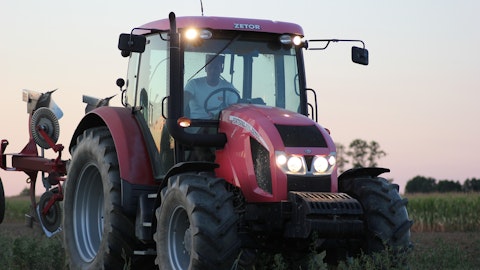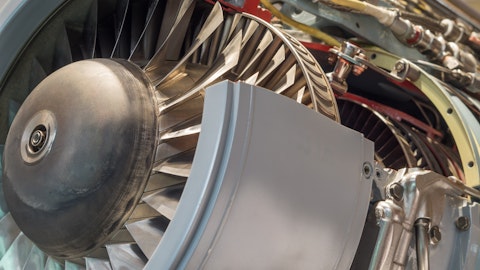Graham Mattison: Got it. Great. And then last question, any update on the partnerships with — or the demo part — the demo programs that you had running with some of the big rental companies?
Raymond Wang: Yes. I can’t share too much at this stage, however, I can say that particularly with some of the rental companies that I’ve named in prior earnings calls, those are still active and developing. I’m extremely pleased with the progress that we’re making. Those relationships definitely take some time to execute into a large fleet deal, let’s say, but they’re still active, they’re still progressing, we’re still in active projects and communication, and I’m extremely pleased with the outcome so far.
Graham Mattison: Is that a potential — I mean, given the timing of how that process works, is that something to look for in 2024?
Raymond Wang: That one is a little harder to say. Our optimistic target is to have some related announcements for it in 2024, but from an actual impact to the balance sheet, that might take until 2025.
Graham Mattison: Got it.
Raymond Wang: Our product lines on the heavy side, they have a six month runway from order to delivery. So it would have to realize itself by June of next year for delivery to hit. So if it’s a national brand rental company worth a drop of 100 or 150 unit order on our desk, then we’d really see in 2025.
Graham Mattison: Got it. That makes sense. Alright. Great. I’ll jump back in queue. Thank you.
Raymond Wang: Thank you.
Operator: Thank you. [Operator Instructions] We will now take the next question. Next question is from a line of Rommel Dionisio from Aegis Capital. Please go ahead.
Rommel Dionisio: Good morning. I wanted to see you just talk about the overall market outlook in the core transmission business in China, obviously, in the wake of the Chinese Premiers visit to the United States and it does seem like you’ve definitely demonstrated strong market share gains and the markets come back. I wonder if you could just talk a little bit about the outlook going into 2024 on a macro level for that market. Thanks.
Raymond Wang: Of course, at a macro level we still continue to see strong global demand for drivetrains and transmissions, particularly on the forklift industry itself. Though the geopolitical environment has been very volatile and challenging and though economies across the world have struggled with the right balance to promote growth in their company — in their countries, we still see at an operational level this significant demand to satisfy the shift towards e-commerce and delivery. That behaviorism to catch up with technology has just taken such a strong foothold across the globe. And it’s really that transition to rely on the logistics to power that, it’s really driving that, that increase in demand for forklifts overall, and that’ll continue to drive our component business.
And that’s a little agnostic right now at this stage to the global affairs. If we were to drill down to the macro level, which brands are going to do better or which countries are going to do better. I can talk about that for a little while. But at the macro sense, we still anticipate it’s going to go strong at most likely a 8% to 10% annual — compound annual growth rate for the next two to four years.
Rommel Dionisio: Okay. That’s very helpful. And maybe one follow-up question if I could. Congratulations first of all on the landmark win with the Port of Baltimore. I wonder, Raymond, if you could just share with us, kind of how that — to the extent that you can, how that kind of played out? What pushed them over the edge to make that order? Just — yes, if you could characterize what really pushed them over the edge to make that decision? Thanks.
Raymond Wang: Yes, it was — what pushed that over was our guiding principle for our sales process, which is getting people behind the wheel. Because this is brand new technology, and it’s been diesel power since — for the past century, we knew that despite all the benefits and cost savings that we can talk about, the best way to get people to feel comfortable is to get them behind the wheel. So that’s what we did. With the Port of Baltimore, we invited them to our site in White Marsh for their operators, and they brought a small school bus full of their operators to try out our equipment. And once they got to operate it firsthand, they saw the quality, they saw the power, they understood the advantages. And at that point in time, they were extremely comfortable to be the first company to pioneer our technology.
And that process did take some time. I will say that the process we won it, let’s say, we improp to won it back — or rather — sorry, the demand for it was entered into procurement in February. However, it took until August of this year before it entered bid and then we were able to officially win that deal. So I called that out because for the asset values of our equipment and for the clientele, it’s a very long sales process, longer than we initially anticipated. Even when we achieved soft victories, just the purchasing process itself can take quarters. So that was a learning lesson and one that I just wanted to share on the call.
Rommel Dionisio: Okay. One last housekeeping question if I could. I noticed you cited higher shipping fees in the quarter. Was that just because of higher units or I thought shipping rates is kind of stabilized? I wonder if you could just clarify that please. Thanks.



